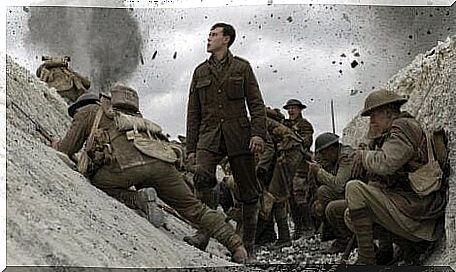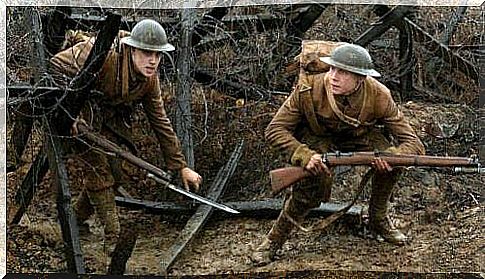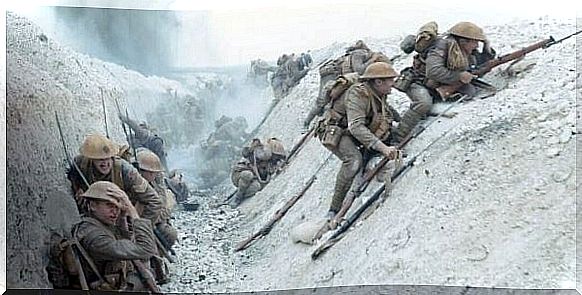The 1917 Movie: Suffering In A Single Shot

The 1917 film started out as one of the big favorites to win the most prized prize at the Oscars. However, he had to settle for technical awards. Parasite was without a doubt a real revelation. It was the film that eventually made history and won the most coveted awards.
Talent knows no languages or boundaries. We saw that clearly with the historic award for best film that went to a South Korean film. But in this article, we’re going to talk about the 1917 movie . It was one of the favorites for the Oscars, but ended up winning more awards in the BAFTAs and the Golden Globes.
” loading=”lazy” width=”500″ height=”281″ src=”https://www.youtube.com/embed /gZjQROMAh_s?feature=oembed” frameBorder=”0″ allow=”accelerometer; autoplay; encrypted-media; gyroscope; picture-in-picture” allowfullscreen=””]
A somewhat forgotten past
There have been countless feature films about World War II and even Vietnam. However, not many films about the First World War have resonated with people all over the world as much. Perhaps one of the most famous is Paths of Glory by the unforgettable Stanley Kubrick, starring the recently deceased Kirk Douglas.
World War I generates more questions than World War II and doesn’t have as much movie potential. Maybe it’s because it’s not so clear who the enemy was.
Maybe it was because of its chaotic nature, which made this difficult to portray in movies. Anyone who thinks of war films will no doubt mention films in which the clear enemy is none other than Nazism.
Inspired by some of the stories he had heard from his grandfather, Sam Mendes dared to plunge into the trenches of the First World War with a simple plot and a sublime mise-en-scene.
The 1917 film hits the right notes
A joke can be told in different ways and, depending on who tells it and how they tell it, it will make us laugh or nothing will happen. This statement, simple as it may seem, can also be applied to film, and also to art in general.
The message is fundamental, there is no doubt about it. If the backstory doesn’t capture our imagination, there’s not much we can do about it. But just like with jokes, the way we tell the story is also fundamental.
The story behind the film couldn’t be simpler. Two wounded soldiers in the British Army must deliver a message to one of their comrades to avoid a massacre at the hands of the enemy.
That’s when something as simple as a message is brought to life and the audience’s empathy can win. The spectators are in deadly silence as their hearts and nerves are on edge in the face of impending death.

Poetic yet stifling at the same time
The film has a cast that includes some of the greats of British cinema of the past decades. Think Colin Firth and Benedict Cumberbatch. However, the director decided to leave most of the acting to two rather unknown young actors.
It’s true that with a different kind of story, he could have looked in more detail at other secondary characters, including the actors we just mentioned. The decision to rely on a small number of protagonists puts the spectators right in the middle of the action.
The trenches have never been so shocking, so poetic and so suffocating at the same time. The viewer can perceive the terror, the loneliness and the desolation. And all this is due to a consummate technique rooted in tension. How is this possible? Thanks to the use of an eternal but illusory sequence shot.
The film 1917 and its unique shot in one shot
It’s not like 1917 invented anything new here. Hitchcock himself experimented with the technique in Rope in 1948. This film was followed by more recent ones, such as Birdman (Joaquin Oristell, 2015) and Victoria (Sebastian Schipper, 2015).
In this way, the film 1917 combines and explores the possibilities of new technology with a technique we have seen on other occasions. The successful implementation ensures that the viewer becomes fully involved with the main characters and helps them to perceive everything in ‘real-time’.
Both the acting and the technical work require a much greater effort. Because when shooting such scenes, everything has to be perfectly measured and calculated to the millimeter, even the atmospheric conditions.
The illusion of recording in one shot, with its millimetric and almost imperceptible cut-offs, gives us, as spectators, that sense of dread. We are no longer passive spectators of a tragedy, but accomplices.
Since the protagonists cannot escape, neither can we. In this sense, the use of natural light, spaces, faces and subtle special effects emphasizes the action.
Caught in the trenches
The viewer feels trapped in the labyrinth of the trenches, empathizes with the protagonists and feels the fear displayed so clearly before their eyes.
Music and image create a chilling beauty in which energy is the key. The camera never looks back, never moves back, but moves forward with the movement of the characters. The music also appears at moments of greatest tension, which in part reminds us of Hitchcock.
The complexity of the 1917 film lies precisely in how difficult it is to take advantage of natural resources such as chiaroscuro (contrasting light and shadow), natural light and the immediacy it tries to convey.
Not to mention a team that managed to recreate a hostile trench-filled scenario in which countless young people died. All recruited for a war that, like all wars, was both senseless and abhorrent.

The film 1917 is a real cinema experience
The feeling of watching a movie filmed in one go, even if it is an illusion, creates uncertainty in the viewer. An uncertainty tragically supported by the longest, most obvious, and meditated shot in the film.
After the main character is shot, everything turns black. An eternal black that brings us far from relief, but increases our suffering. Is it all over? Will we now see normal scenes with lots of shots?
No, absolutely not, the drastic pause only serves as a temporary pause before the story continues to tell, which has so much more to say and should show us even more intense suffocating scenes.
The film received ten nominations, but won only three Oscars; they were all technical awards, but still very important. A movie is nothing without a solid script, but it doesn’t come alive just because of the script.
From clothing to music, from acting to portraying. A film is a complex art, a difficult project in which all elements are important and fundamental.
This is probably one of my least impartial articles, but as with all criticism and art, taste plays a fundamental role. I’m not a fan of war movies that turn towards anti-war. However, I am a great admirer of Mendes and Roger Deakins (the genius responsible for photography in 1917).
Overwhelmed by hostility
Mendes captivated me with American Beauty. He hypnotized me and immediately took me to a movie that, while it didn’t have too many surprises, still gripped me and continues to fascinate me to this day.
He showed me beauty in a plastic bag, and now he has managed to overwhelm me and find beauty in a hugely hostile environment.
All these scenes exist to not tell us something that we already know and that the cinema has repeated on countless occasions – that wars are nonsensical, that people are nonsensical and that nature goes on just as well.
Getting through these suffocating scenes and seeing the cherry tree in bloom at the same time has never been more important. Seeing death where nature comes to life, or seeing the destruction of man in such a natural environment struggling to flourish, is poetic, liberating and revealing.
A lesson in humility
Nature acts as another character in this film. It is far away from humans yet ubiquitous. In this film, the tree emerges as its main symbol. It is present at both the beginning and the end of the film, making it a truly cyclical experience.
And yet, beyond all these fascinating technicalities, the 1917 film is a lesson in humanity. It is a clear tribute to those who lived through the Great War. To those who saw death in their hands and buried their hopes in mud.









